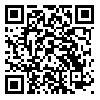Volume 8, Issue 4 (volume8, Issue 4 2021)
CPJ 2021, 8(4): 29-40 |
Back to browse issues page
Download citation:
BibTeX | RIS | EndNote | Medlars | ProCite | Reference Manager | RefWorks
Send citation to:



BibTeX | RIS | EndNote | Medlars | ProCite | Reference Manager | RefWorks
Send citation to:
Lohrasbi S, Moradi A, Sadeghi M. Functional Pattern of the Basic Emotion Recognition in Iranian People by CANTAB a Computerized Assessment. CPJ 2021; 8 (4) :29-40
URL: http://jcp.khu.ac.ir/article-1-3314-en.html
URL: http://jcp.khu.ac.ir/article-1-3314-en.html
Kharazmi university , moradi90@yahoo.com
Abstract: (8611 Views)
Emotion Recognition is the main component of social cognition. The failure in emotion recognition can jeopardize the survival of the human in the environment. Emotion recognition has various pattern in different cultures and nationalities. Some of the emotions would recognize as strong or weak. Also, there is diversity in emotion recognition pattern in some psychological disorders and neurological damages. Finding the Iranian emotion recognition pattern with a valid neuro-psychological test is the main purpose of this study. This is a descriptive-analytical study. Participants with the age of 24 to 40 years were initially tested in computer intelligence and progressive matrices of Raven-2 Then, for 88 subjects who had obtained a normal score in the RAVEN-2 test, the excitement recognition subtest was taken from the Cambridge Neuro-Psychological test automated battery (CANTAB). The correct response of participants to each of the six emotions used for analysis. The average percentage of correct responses to each of the six emotions has been analysis by SPSS statistical software. The normal distribution and spherical condition exist among the accumulated data. The maximum rate of correct responses was 75.83% related to happy emotion, sad 70.00%, Surprise 68.48%, disgust 47.84%, angry 42.54%, and fear 38.26%. Iranians recognized happy emotions better than the other emotions and fear was the lees recognized emotion. The finding of this study can affect the evaluation of cognitive elements in the particular society like Iran and can identify the most cognitive abilities and inabilities in people. The result of this research deduces striking findings that can lead the evaluation of cognitive, social people of Iran.
Type of Study: Applicable |
Subject:
Special
Received: 2020/09/4 | Accepted: 2021/03/10 | Published: 2021/03/10
Received: 2020/09/4 | Accepted: 2021/03/10 | Published: 2021/03/10
Send email to the article author
| Rights and permissions | |
 |
This work is licensed under a Creative Commons Attribution-NonCommercial 4.0 International License. |






